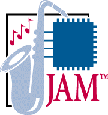JAM (5244/jam002) |
 |
Automatic testing language
Automatic testing language from Altera
References:
A consortium of companies consisting of PLD suppliers, programming tool manufacturers, and test systems manufacturers is backing the Jam proposal. By using Jam, designers can eliminate the confusion of multiple proprietary file formats, vendor-specific algorithms, large file sizes, and long programming times. The Jam language is optimized for programming devices through the IEEE 1149.1 TAP controller that's part of JTAG standard, and allows the specification of both the programming data and the programming algorithm in one file. Once created, the file contains all of the information required to program a specific design across multiple PLDs connected in a JTAG daisy chain.
Two software components comprise the Jam programming solution-the Jam Composer and the Jam Player. The composer creates the Jam file required to program a specific design into a specific device, while the Player interprets the Jam file and programs the target device. The Composer typically resides on the development tools that accept the configuration pattern developed by the PLD logic design tools. The Player can either reside in the PLD tools or locally on the board containing the PLDs to be configured.
Included in the Jam language are constructs such as For-Next loops and other commands that make it code-efficient. A fully expanded file to program a 128-macrocell PLD typically exceeds 20 Mbytes, while the equivalent file would require only about 8 kbytes when created with Jam. Moreover because the Jam Composer includes chip-specific programming algorithms, each PLD can be programmed with the optimum pulse width. This minimizes the programming time required for each device and often reduces the system programming time by a factor of ten or more.
Resources
- JAM home page
The Jam? Standard Test and Programming Language (STAPL), JEDEC standard JESD-71, is a standard file format for in-system programmability (ISP) purposes. Jam STAPL is designed to support programming or configuration of programmable devices and testing of electronic systems, using the IEEE 1149.1 Joint Test Action Group (JTAG) interface. Jam STAPL is a freely licensable open standard.
Jam STAPL was created by Altera® engineers and is supported by a consortium of programmable logic device (PLD) manufacturers, programming equipment makers, and test equipment manufacturers. Jam STAPL was adopted as JEDEC standard JESD-71 in August, 1999.
Jam STAPL addresses the issues that designers face when programming PLDs in-system. These issues include proprietary file formats, vendor-specific programming algorithms, large file sizes, and long programming times. Jam STAPL is a major step forward in providing a software-level standard for in-system programming.
external link - JAM logo